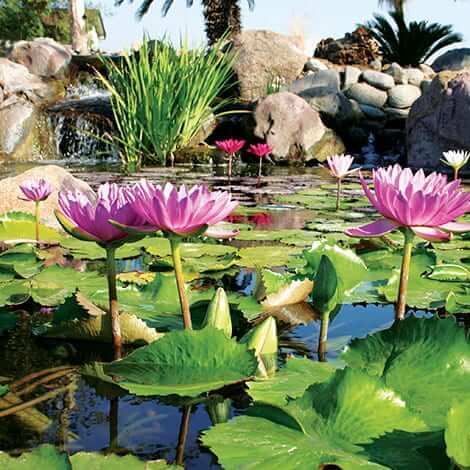Adding aquatic plants is a great way to customize your aquascape and balance your pond ecosystem. There are five key components to consider when planning a water garden, including aquatic plants, so here are a few reasons why plants are such an essential part of any pond.
- Algae Control: Fish waste and decomposing organics fertilize your pond and contribute to algae blooms. Pond plants help with algae by using up these nutrients, thus reducing what is available for unwanted vegetation. Plants also shade your pond from excess sunlight, further inhibiting algae overgrowth. Aim to cover around half of your pond's surface area with plants, especially if it gets direct sunlight for most of the day.
- Natural Sunblock: Just like people, fish can suffer from painful sunburns. Since they don't make sunscreen for fish, use floating pond plants with ample foliage, like water lilies, to give your finned friends the relief they need on sunny summer days.
- Predator Protection: Another critical benefit of plants in koi ponds is protection from predators like herons that hunt by sight. Aquatic plants provide hiding spaces so your fish can outsmart those pesky birds.
- Improved Water Quality: Aquatic plants help clean pond water by acting as natural water filters. They remove excess nutrients from the pond while releasing oxygen during photosynthesis. If your water garden has cloudiness or poor water quality issues, consider incorporating more plants to help clean it up.
- Home Sweet Home: Plants create ideal habitats for your aquatic life above and below the waterline by offering food and shelter. Fish and snails hang out around the leaves and stems, while frogs hunt for bugs and hide in the shade. The leaves, stems, and root systems of aquatic plants give your pond life safe places to spawn and lay their eggs. When those tiny fry hatch, plants provide protection, food, and a cozy place to call home.
- Aesthetics: Flowering pond plants add color and dimension to your backyard, which you will enjoy all season. Marginal plants can also help camouflage equipment in and around your pond, such as waterfall boxes and pumps.
Types of Aquatic Plants
A good mix of aquatic plants does more than beautify your water garden. The marginal, floating, and submerged plants absorb excess nutrients in the water and shade the pond's surface, which helps prevent algae while protecting your fish from hungry predators. Here are the various types of aquatic plants you should consider:
- Floating Plants: Water hyacinth, water lettuce, giant sensitive plant, and other floating plants are excellent options for filtering the nutrients that cause excessive algae growth. They also provide shade and cover for fish and other aquatic organisms.
- Submerged Plants: Popular submerged aquatic plants include hornwort and eelgrass. These fantastic filters and oxygenators absorb excess nutrients from the water, so fertilizing them is unnecessary.
- Bog Plants: Bog plants are sown around the perimeter of your pond or in shallow, marshy areas. There is a lot of color, size, and shape variety, so they will surely attract the attention of people and wildlife alike. Bog plants like water forget-me-not and creeping Jenny are invasive perennials, so you may see them return and spread each year, depending on your zone.
- Water Lilies: Available in cold-tolerant and tropical varieties, lilies are definite crowd-pleasers. Hardy water lilies are perennials that blossom all summer on the pond's surface. Tropical lilies have very fragrant blossoms and produce several flowers at once. Some bloom in the daytime, while others are night-blooming lily flowers.
- Water Lotus: These plants are larger than life, standing two to five feet above the water, depending on the variety. Water lotus have large blooms and leaves to help keep your pond protected from the sun. These may take up to two years to become fully established in your water garden. Get the best growth by using our all-in-one Planting Kits for Water Lilies & Lotus.
Beneficial Aquatic Plant Care Advice
During the growing season, plan to fertilize your water lilies and marginal plants once per month. Floating and submerged plants should have plenty of nutrients in the water to feed them. If you have more questions about caring for your pond plants, contact us online or by phone at 866-766-3435 for prompt, personalized advice.
Read more about growing and maintaining aquatic plants below:
How to Pick Aquatic Plants
How to Plant Water Lily
Do Pond Plants Clear the Water?
Seasonal Pond Plant Maintenance
How to Divide Bog Plants & Water Lilies
Last Updated: April 10, 2024
